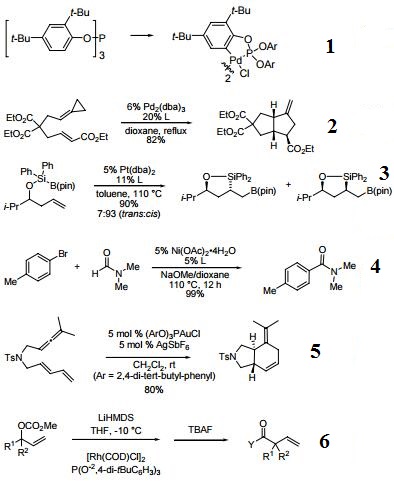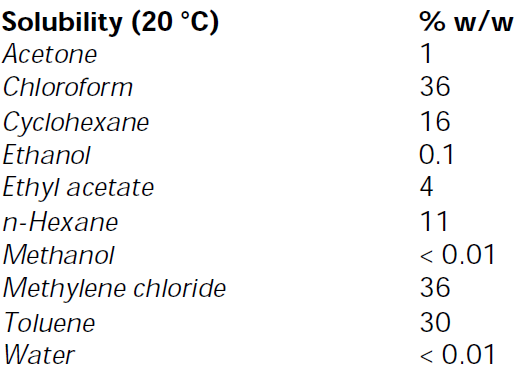| Identification | More | [Name]
Tris(2,4-ditert-butylphenyl) phosphite | [CAS]
31570-04-4 | [Synonyms]
IRGAFOS 168
PHOSPHORIC ACID-TRIS(2,4-DI-TERT-BUTYLPHENYLESTER)
PHOSPHOROUS ACID TRIS(2,4-DI-TERT-BUTYLPHENYL) ESTER
TRIS(2,4-DI-T-BUTYLPHENYL)PHOSPHITE
TRIS(2,4-DI-TERT-BUTYLPHENYL) PHOSPHITE
2,4-bis(1,1-dimethylethyl)-phenophosphite(3:1)
ANTIOXIDANT168
Phenol,2,4-bis(1,1-dimethylethyl)-,phosphite(3:1
Phenol,2,4-bis(1,1-dimethylethyl,phosphite(3:1)
tri(2,4-Ditertrabutylphenyl)phosphiteester
Tris(2,4-di-tert-butylphenyl)phoshit
Trisditbutylphenylphosphite
TRIS(2,4-DI-T-BUTYLPHENYL)PHOSPHITE 98%
TRIS-2,4-DI-TERT-BUTYL PHENYLPHOSPHITE (DOVERPHOS 480)
Tris(2,4-ditert-butylphenyl)phosphate
Tris(2,4-di-t-butylphenyl)phosphite,98%
Tris(2,4-di-tert.-butylphenyl)phosphit
2,4-bis(1,1-dimethylethyl)-pheno phosphite
Phenol, 2,4-bis(1,1-dimethylethyl, phosphite
Phenol,2,4-bis(1,1-dimethylethyl,phosphite | [EINECS(EC#)]
250-709-6 | [Molecular Formula]
C42H63O3P | [MDL Number]
MFCD00072706 | [Molecular Weight]
646.92 | [MOL File]
31570-04-4.mol |
| Chemical Properties | Back Directory | [Melting point ]
181-184 °C(lit.)
| [Boiling point ]
594.2±50.0 °C(Predicted) | [density ]
-0.98 | [Fp ]
46°C (115°F) | [storage temp. ]
2-8°C | [solubility ]
Acetonitrile (Slightly), Chloroform (Sparingly), Ethyl Acetate (Sparingly, Heate | [form ]
Powder | [color ]
white | [Specific Gravity]
0.98 | [Hydrolytic Sensitivity]
4: no reaction with water under neutral conditions | [Sensitive ]
moisture sensitive | [Stability:]
Moisture Sensitive | [InChIKey]
JKIJEFPNVSHHEI-UHFFFAOYSA-N | [LogP]
18 at 25℃ | [CAS DataBase Reference]
31570-04-4(CAS DataBase Reference) | [EPA Substance Registry System]
31570-04-4(EPA Substance) |
| Questions And Answer | Back Directory | [Characterization]
Antioxidant 168 is a hydrolytically stable phosphite processing stabilizer. As a secondary antioxidant,Antioxidant 168 reacts during processing with hydroperoxides formed by autoxidation of polymers preventing process induced degradation and extending the performance of primary antioxidants.
| [Reactions]
- Precursor to a palladacyclic catalyst for Suzuki, Stille and Heck processes.
- Ligand for Pd-catalyzed [3+2] intramolecular cycloaddition of alk-5-enylidenecyclopropanes.
- Ligand for Pt-catalyzed intramolecular silaboration of alkenes.
- Ligand for Ni-catalyzed aminocarbonylation of aryl halides.
- Ligand for the Au-catalyzed [4+2] intramolecular cycloaddition of allene-dienes.
- Rhodium-Catalyzed Allylic Substitution with an Acyl Anion Equivalent.

| [Applications]
The application range of Antioxidant 168 -synergistically combined with other Ciba anti-oxidants - comprises polyolefins and olefin-copolymers such as polyethylene (e.g. HDPE, LLDPE), polypropylene, polybutene and ethylene-vinylacetate copolymers as well as polycarbonates and polyamides. The blends can also be used in polyesters, styrene homo- and copolymers, adhesives and natural and synthetic tackifier resins, elastomers such as BR, SEBS, SBS, and other organic substrates. Antioxidant 168 blends can be used in combination with light stabilizers of the TINUVIN and CHIMASSORB range.
| [Features/benefits]
Antioxidant 168 is an organophosphite of low volatility and is particularly resistant to hydrolysis. It
protects polymers which are prone to oxidation, during the processing steps (compounding/
pelletizing, fabrication and recycling) from molecular weight change (e.g. chain scission/crosslinking)
and prevents discoloration.
Antioxidant 168 performs best when combined with other Ciba antioxidants. Blends of Antioxidant 168
with antioxidants of the IRGANOX range (IRGANOX B-blends) and with Hydroxylamine FS042 are
particularly effective. The IRGANOX range antioxidants additionally provide storage stability and give
the polymer long term protection against thermo-oxidative degradation.
Antioxidant 168 comprised in phenol free systems with other appropriate Ciba stabilizers addresses
specific stabilization requirements.
| [Guidelines for use]
Typically 500 - 2000 ppm of Antioxidant 168 combined with appropriate levels of other additives are used for the processing stabilization of polymers. The optimum level is application specific. Extensive performance data of Antioxidant 168 combinations in various organic polymers and applications are available upon request.
| [Physical Properties]
 | [Safety]
In accordance with good industrial practice, handle with care and prevent contamination of the
environment. Avoid dust formation and ignition sources.
For more detailed information please refer to the material safety data sheet.
|
| Hazard Information | Back Directory | [Description]
ANTIOXIDANT 168 is a secondary antioxidant with excellent resistance to extraction by water, low volatility and high heat stability. It can effectively decompose hydroperoxides produced during the processing of polymeric materials. ANTIOXIDANT 168 usually not used alone, is compounded with hindered phenolic primary antioxidants such as 1010 to improve thermostability of polymer during the processing. There are over ten kinds of blends of 168 with phenolic antioxidants, widely use in the polymer materials such as PE, PP, PA, PC, ABS and so on. | [Uses]
This product is an excellent Antioxidant wnameely applied to polyethylene, polypropylene, polyoxymethylene, ABS resin, PS resin, PVC, engineering plastics, binding agent, rubber, petroleum etc. for product polymerization. | [Application]
Antioxidant 168 is a kind of phosphite ester antioxidant as processing stabilizer, used for polypropylene, polyethylene, and adhesives. The amount to be used may be 0.1%~1.0% depending on the substrate, processing conditions, and requirements of the end application. Blends with hindered phenols are particularly effective.In addition, they use combination with light stabilizers when need. | [Definition]
ChEBI: Phenol, 2,4-bis(1,1-dimethylethyl)-, phosphite (3:1) is an alkylbenzene. | [General Description]
Tris(2,4-di-tert-butylphenyl) phosphite is a triaryl based phosphite that can be used in catalysis and metallation. Its characteristic to undergo metallation reaction and provide a cost effective synthetic processes allows it to be useful in biaryl coupling reactions. | [Flammability and Explosibility]
Notclassified | [Properties and Applications]
|
TEST ITEMS
|
SPECIFICATION
|
|
APPEARANCE
|
WHITE INCOMPACT POWDER
|
|
CONTENT
|
99.0% min
|
|
MELTING RANGE
|
183-187 °C
|
|
VOLATILE
|
0.3% max
|
|
SOLUBILITY 2g/20ml TOLUENE
|
CLEAR
|
|
FREE 2,4-DITERT-BUTYPHENOL
|
0.2% max (wt)
|
|
TRANSMITTANCE
|
98% min 425nm
|
|
98% min 500nm
|
|
ACID VALUE,mg KOH/g
|
0.3% max
|
|
HYDROLYSIS TIME (90°C
WATER
)
|
14 h min
|
|
SOLUBILITY
|
1% ACETONE
|
|
30% TOLUENE
|
|
36% CHLOROFORM
|
|
4% ETHYL ACETATE
|
|
11% n-HEXANE
|
|
0.1% ETHANOL
|
|
36% DICHLOROETHANE
|
|
6% max PHENYLETHYLENE
|
|
0.01% max WATER
|
|
|
|